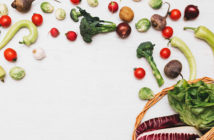The air is getting cooler, that means it’s time for fall. Typically, when fall hits, you think of the holidays and all the foods you don’t normally eat the rest of the year. This is the perfect time to pay attention to what you’re eating so that you don’t pack on the pounds.
Here’s a list of superfoods to include in your eating plans for fall.
Cauliflower
Cauliflower is perfect for winter side dishes because of it’s sweet, slightly nutty flavor. You can serve it steamed, blended into a mashed potato-like texture, or pureed into soup. Cauliflower contains compounds that may help to prevent cancer and Phytonutrients that may lower cholesterol. It’s also an excellent source of vitamin C.
Availability: September–June
Try this recipe Grilled Spiced Cauliflower Recipe
Winter Squash
Winter squash has a fine texture, a slightly sweet flavor, and can be stored for months. Add flavorings like cinnamon and ginger to make the taste stand out. Winter squash contains omega-3 fatty acids and is an excellent source of vitamin A.
Availability: October–February
Try this recipe Winter Vegetable Risotto
Pumpkin
Pumpkin is actually a type of winter squash. It has a sweet taste and moist texture which make it ideal for pies, cakes, and pudding! Pumpkin is rich in potassium, provides more than 20% of your Daily Recommended Intake of fiber, and is a good source of B vitamins.
Availability: October–February
Try this recipe Paleo Pumpkin and Carrot Muffins
Sweet potatoes
Sweet potatoes are more nutritionally dense than their white potatoes. They are great roasted or baked. Sweet potatoes are an excellent source of vitamin A, good source of iron, and provide anti-inflammatory benefits.
Availability: September–December
Try this recipe Vegan Lentil & Sweet Potato Shepherd’s Pie
Turnips
Turnips are root vegetables and serve as a great alternative to radishes and cabbage. Use fennel, bread crumbs, or even brown sugar to add flavor. Turnip leaves, which taste like mustard leaves, are easy to cook and dense in nutrients. Turnips roots are a good source of vitamin C and the leaves are an excellent source of vitamins A, K, and folate.
Availability: September–April
Try this recipe Vegetable Curry
Pomegranates
Pomegranates are a bit sour, but are also antioxidant powerhouses. The juice provides a tangy base for marinades, and the seeds can be tossed into salads to amp up the flavor. Pomegranate juice has higher antioxidant levels than red wine and are a good source of vitamin C and folate.
Availability: August–December
Try this recipe Winter Salad With Champagne Vinaigrette and Pomegranate
Dates
Dates are the perfect braised in stews, chopped up in desserts, or stuffed with cream cheese or almonds. Dates are low in fat, a good source of fiber and potassium.
Availability: September–December
Try this recipe Raw Berry Red Velvet Short Cake
Kiwi
Kiwis are great mixed with strawberries, cantaloupe, or oranges and can be combined with pineapple to make a tangy chutney. Kiwis offer more vitamin C than an orange and are a good source of potassium and copper.
Availability: September–March
Try this recipe Fresh Fruit Smoothie
Grapefruit
The tartness of grapefruit makes it a great add on to mixed greens. You can also combine it with avocado and shrimp, or enjoy a fresh glass juice. Grapefruit offers more than 75% of your daily recommended intake (DRI) of vitamin C, is a good source of lycopene, and contains pectin, which has been shown to lower cholesterol.
Availability: September–April
Try this recipe Skinny Margarita
Apples
Apples are great eaten raw or baked into a dish. Make sure you eat the skin it’s rich in heart-healthy flavonoids. Apples are full of antioxidants, and contain at least 4 grams of dietary fiber per serving.
Availability: August-November
Try this recipe Slow Cooker Steel Cut Oats and Apples
Brussels sprouts
Brussels sprouts have a mild, somewhat bitter taste, so combine them with tangy or savory sauces, like balsamic vinegar. ½ cup of Brussels sprouts contains more than your DRI of vitamin K, and are a good source of folate and of iron.
Availability: September–March
Try this recipe One-Pot Squash and Brussels Sprouts Panzanella with Dried Cherries
Pears
Pears are sweet and juicy, cooking can really bring out their fabulous flavor. Try them baked or poached. Pears are a good source of vitamin C and copper and contain at least 4 grams of fiber per serving.
Availability: August–February
Try this recipe Maple Nut and Pear Scones
Did you catch our Facebook Live on how we created Mock Tuna Salad? If you missed it, you can watch it here:
Here’s the recipe so you can make it yourself.
Mock Tuna Salad
Enjoy with dark rye bread for rye crackers, dress the salad with Romaine Lettuce and slice tomatoes.
Ingredients:
1 clove garlic, chopped
1/2 cup chopped sweet onions
2 stalks celery, chopped
1/2 cup chopped fresh or 1/8 to 1/4 dried parsley
1/3 cup Veganise Mayo
1 Tbsp. finely chopped fresh basil or 1 tsp. dried basil
1 /2 tsp. dried oregano
1/4 tsp. cumin
3 cups cooked mashed garbanzo beans (chickpeas)
1/4 cup bean stock or vegetable stock
3 Tbsp. Olive Oil
2 Tbsp. fresh lemon juice
1/2 tsp. salt
Method:
Mix all of the ingredients together with a fork, and serve chilled over a bed of Romaine lettuce. Makes 3 1/2 cups- 1/2 cup per serving
NYC Nutrition Analysis (per serving or yield unit): calories=248; protein=6.21 g; total fat=14.77 g; saturated fat=1.82 g; monounsaturated fat=4.92 g; polyunsaturated fat=0.71 g; carbohydrate=21.98 g; dietary fiber=6.21 g; total sugars=2.12 g; calcium=5.27 mg; ; iron=0.1 mg; sodium=391.9 mg; potassium=31.84 mg; vitamin A=1.16; vitamin B6=0.03 mg; vitamin C=3.44 mg;
Ready to discover healthy ways to keep you feeling great, decreases toxins and keep your body functioning properly?
Kickstart your healthy lifestyle with 7 days of real, actionable strategies that work for Free.




